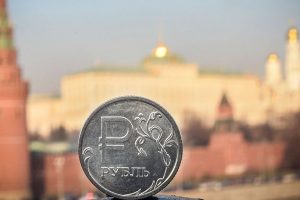Putin’s ruble surges to 2-year high against euro while in climb back to pre-war levels

Gazprom: Ursula von der Leyen urges against paying in Rubles
We use your sign-up to provide content in ways you’ve consented to and to improve our understanding of you. This may include adverts from us and 3rd parties based on our understanding. You can unsubscribe at any time. More info
Moscow’s currency has now reached highs of just over 74 to the euro, its strongest position since March 2020. The currency has also strengthened its position against the dollar, climbing back to pre-conflict levels. Part of the divergence with the euro has also been driven by a decline in the single currency which has seen a sharp sell-off this week. The euro is now at a five-year low against the dollar with fears over the growth outlook for the eurozone as the impacts of Russia’s war begin to spill over.
Meanwhile Russia’s central bank has begun unwinding emergency measures brought in to prop up the ruble with interest rates being further cut to 14 percent.
In the wake of international sanctions the bank announced an emergency hike to 20 percent in a bid to prop up the currency and avert a run on the banks.
In a statement the Bank of Russia said: “Risks to price and financial stability have ceased to grow, which created the conditions for a reduction in the key rate.”
However it admitted: “The external environment for the Russian economy remains challenging and significantly limits economic activity.”


Since the invasion the ruble has had a volatile time, initially crashing in value with scenes of Russians queueing at ATMs to withdrawn money and convert it into safer forms.
The ruble has since developed something of an artificial exchange rate with the Bank of Russia introducing wide ranging currency controls to prop it up.
Restrictions so far have included temporarily banning sales of foreign currencies to individuals and limiting withdrawal of foreign money to less than $10,000.
In a further bid to support the ruble President Putin has decreed that payment for energy from so-called “unfriendly countries” must be made in the Russian currency.

Following supplies being cut to Poland and Bulgaria after their refusal, energy firms in Germany, Italy and Austria are understood to be opening ruble accounts to maintain supplies.
Despite the ruble’s current strengthening the Russian economy still faces a challenging future ahead though.
According to the central bank’s forecasts 2022 will see GDP contract by eight to 10 percent with inflation risks still remaining “significant”.
In April inflation reached 17.6 percent with the bank forecasting this will continue to grow to reach 18-23 percent this year.
DON’T MISS:
German inflation refuses to fall as 40 year high reached [REVEAL]
AstraZeneca under fire for raking in millions with Covid-19 jab [SPOTLIGHT]
Putin oil block sparks price surge with Europe recession fears [ANALYSIS]

The bank admitted: “The reduction in the potential of the Russian economy due to restrictive measures may be more significant than assumed in the baseline scenario.”
Nevertheless it predicts inflation will return to its four percent target by 2024 with further cuts to interest rates possible this year.
Source: Read Full Article
